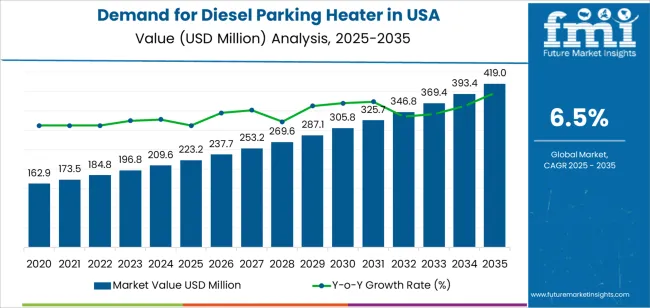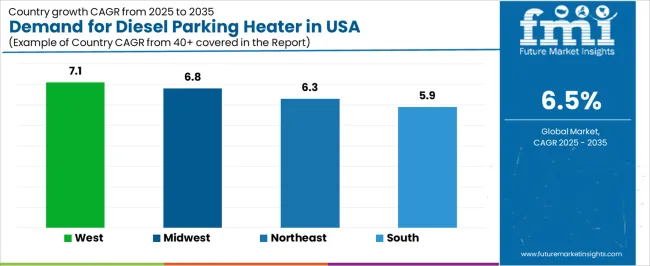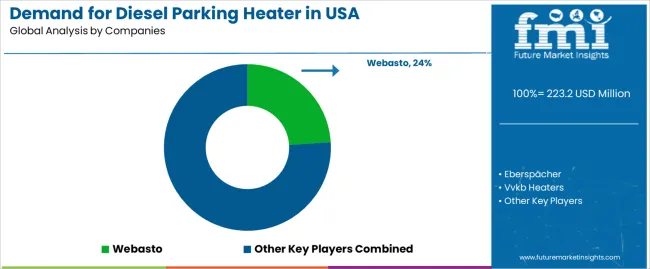The demand for diesel parking heaters in the USA is anticipated to grow from USD 223.2 million in 2025 to approximately USD 419.0 million by 2035, recording an absolute increase of USD 163.2 million over the forecast period. Demand for diesel parking heaters in the United States is expected to grow at a total rate of 73.1%, with demand forecast to expand at a CAGR of 6.5% between 2025 and 2035. This is stronger than many global averages, where growth often sits between 4% and 5%. The increase in the USA is linked to the structure of its commercial fleet system. Long-haul trucking in the USA covers large interstate distances, making overnight cabin heating a routine requirement rather than a seasonal or occasional need. In such settings, letting the engine idle wastes fuel.
A parking heater can cut fuel use during rest periods by several liters per night, which compounds into large annual savings across fleets. This cost pattern is one of the main reasons the ≤5kW category accounts for 72.4% of the market, as smaller, fuel-efficient systems align with fleet budgets and cabin-size needs. The West and Midwest together account for more than half of incremental growth because these regions experience both harsher cold weather and heavy freight activity. The demand for diesel parking heaters nearly doubled over 10 years in the United States, from USD 223.2 to USD 419.0 million, indicating that adoption is steadily increasing as more fleet operators replace older heating methods. Recreational vehicles add another stable demand layer, especially in the USA, where RV culture is large compared to many regions globally.

Increasing integration of smart heating control systems in commercial vehicle applications and growing adoption of emission-compliant heating technologies continue to drive demand. Fleet operators are expanding their heating capabilities to address the growing complexity of modern operational requirements and regulatory specifications, with USA operations leading investments in advanced diesel heating systems. From 2030 to 2035, demand is forecast to grow from USD 303.5 million to USD 419.0 million, adding another USD 82.9 million, which constitutes 50.8% of the overall ten-year expansion. This period is expected to be characterized by the expansion of connected vehicle heating technologies, integration of automated fuel management systems and performance monitoring networks, and development of specialized heating pathways across different commercial applications. The growing adoption of fleet efficiency principles and enhanced emissions compliance requirements, particularly in the West and Midwest regions, will drive demand for more sophisticated heating systems and specialized power output specifications.
Between 2020 and 2025, diesel parking heater demand grew steadily, driven by increasing cold-weather operational requirements in transportation sectors and growing awareness of auxiliary heating benefits for fuel conservation and driver comfort. The sector developed as fleet operators and transportation companies, especially in major logistics corridors, recognized the need for proven heating solutions and reliable fuel management to achieve operational targets while meeting driver welfare expectations and emission compliance requirements. Equipment suppliers and heating manufacturers began emphasizing proper performance optimization and application integration to maintain operational efficiency and commercial viability.
| Metric | Value |
|---|---|
| USA Diesel Parking Heater Sales Value (2025) | USD 223.2 million |
| USA Diesel Parking Heater Forecast Value (2035) | USD 419.0 million |
| USA Diesel Parking Heater Forecast CAGR (2025-2035) | 6.5% |
Demand expansion is being supported by the accelerating focus on fleet efficiency and operational cost optimization nationwide, with the USA maintaining its position as a commercial vehicle and transportation innovation leader, and the corresponding need for effective auxiliary heating systems to enhance driver comfort, conserve fuel, and protect engines. Modern fleet management strategies rely on diesel parking heater technologies to ensure operational competitiveness, regulatory compliance, and optimal pathway achievement toward efficiency-focused vehicle operations. Cold climate operational requirements necessitate comprehensive heating solutions, including advanced combustion processing, fuel management capabilities, and emissions control infrastructure to address diverse application needs and performance specifications.
The growing focus on driver welfare standards and increasing federal and state-level transportation regulations, particularly operational efficiency commitments across USA, are driving demand for auxiliary heating systems from proven equipment suppliers with appropriate heating expertise and quality management capabilities. Fleet operators and transportation companies are increasingly investing in heating technology sourcing and integrated thermal management solutions to enhance operational profiles, access driver comfort trends, and demonstrate equipment leadership in competitive transportation environments. Transportation policies and emissions compliance requirements are establishing standardized heating pathways that require auxiliary heating systems and performance assurance, with USA fleet operations often pioneering large-scale implementation of diesel heating technologies.
Demand is segmented by power output, application, and region. By power output, sales are divided into ≤5kW and >5kW categories. In terms of application, sales are segmented into automobiles, pickup trucks, campers, motorhomes, and others. Regionally, demand is divided into West, Midwest, Northeast, and South, with the West representing a key growth and innovation hub for diesel parking heater technologies.

The ≤5kW segment is projected to account for 72.4% of USA diesel parking heater demand in 2025, making it the leading power output category across the sector. This dominance reflects the fuel efficiency and operational suitability of lower-power heating systems for existing commercial vehicle fleets and recreational applications, where heating performance is optimized through controlled fuel consumption processes. Inthe USA, where substantial commercial transportation infrastructure requires auxiliary heating integration without complete vehicle system replacement, ≤5kW systems provide practical pathways for driver comfort enhancement while maintaining fuel economy continuity. Continuous innovations are improving heating efficiency, fuel consumption characteristics, and installation compatibility parameters, enabling fleet operators to achieve high performance standards while minimizing operational cost increases. The segment's strong position is reinforced by the extensive existing commercial vehicle infrastructure requiring heating adoption and growing availability of ≤5kW heating technology suppliers with proven commercial experience.

Automobile applications are expected to represent 41.6% of USA diesel parking heater demand in 2025, highlighting the critical importance of passenger vehicle heating requiring auxiliary thermal solutions. Automobile facilities including personal vehicles, fleet cars, specialty transportation, and commercial passenger applications generate consistent demand for heating systems that are technically and economically favorable for diesel heating applications. The segment benefits from heating characteristics that often provide superior fuel efficiency compared to engine idling alternatives, reducing operational complexity and costs. Automobile applications also access enhanced driver comfort through auxiliary heating positioning that improve vehicle performance and appeal. In USA, where passenger vehicle innovation represents substantial portions of automotive industry development, auxiliary heating deployment requires diesel parking heater integration across diverse automobile operations. In West and Northeast regions, where vehicle comfort concentrations are significant, diesel parking heater demand is elevated by focus on maintaining operational efficiency while achieving driver comfort integration targets.
USA diesel parking heater demand is advancing steadily due to increasing fleet efficiency and growing recognition of auxiliary heating necessity for commercial transportation development, with West region serving as a key driver of innovation and application development. The sector faces challenges, including competition from electric heating alternatives, the need for specialized installation equipment development, and ongoing concerns regarding emissions compliance and fuel cost considerations. Federal transportation guidelines and state-level efficiency initiatives, particularly fleet management programs in West and Midwest regions, continue to influence heating selection and deployment timelines.
The enhancement of fleet efficiency regulations, gaining particular significance through DOT driver welfare guidelines and transportation safety campaigns, is enabling equipment suppliers to achieve differentiation without prohibitive installation costs, providing predictable demand patterns through commercial vehicle requirements and operational efficiency preferences. Enhanced driver comfort standards offering substantial opportunities for auxiliary heating systems and thermal management applications provide foundational dynamics while allowing suppliers to secure fleet agreements and application partnerships. These trends are particularly valuable for first-mover suppliers and premium heating development that require substantial technology investments without immediate cost advantages.
Modern equipment suppliers and fleet operators are establishing advanced heating control networks and centralized thermal management facilities that improve operational efficiency through heating standardization and economies of scale. Integration of automated control systems, real-time performance monitoring, and coordinated fuel management enables more efficient heating operation across multiple vehicle sources. Advanced heating concepts also support next-generation vehicle applications including specialized fleet integration, transportation cluster optimization, and regional heating supply networks that optimize system-level economics while enabling comprehensive driver comfort across commercial transportation regions, with USA developments increasingly adopting collaborative heating models to reduce individual operator costs and accelerate deployment.

| Region | CAGR (2025-2035) |
|---|---|
| West | 7.1% |
| Midwest | 6.8% |
| Northeast | 6.3% |
| South | 5.9% |
USA diesel parking heater demand is witnessing consistent growth, supported by rising fleet efficiency, expanding driver comfort requirements, and the deployment of advanced heating technologies across regions. West leads the nation with a 7.1% CAGR, reflecting progressive transportation trends, substantial commercial vehicle innovation, and early adoption of premium auxiliary heating systems. Midwest follows with a 6.8% CAGR, driven by extensive commercial transportation infrastructure, favorable fleet demographics, and concentration of logistics operations that enhance application development. Northeast grows at 6.3%, as fleet modernization and transportation efficiency opportunities increasingly drive heating deployment. South demonstrates growth at 5.9%, supported by expanding commercial vehicle facilities and regional fleet management initiatives.

Demand for diesel parking heater in West is projected to exhibit exceptional growth with a CAGR of 7.1% through 2035, driven by progressive fleet efficiency preferences, substantial commercial transportation development creating premium heating opportunities, and concentration of innovation across California and surrounding states. As the dominant region with extensive logistics infrastructure and efficiency-focused operational policies, West's focus on comprehensive fleet management and equipment leadership is creating significant demand for advanced diesel parking heater systems with proven performance and reliable application potential. Major fleet operators and equipment suppliers are establishing comprehensive heating development programs to support commercial transportation innovation and premium heating deployment across diverse applications.
Midwest is expanding at a CAGR of 6.8%, supported by extensive commercial transportation facilities including long-haul trucking, freight operations, and logistics establishments generating concentrated demand favorable for auxiliary heating systems. The region's operational characteristics, featuring substantial fleet operations and transportation efficiency requirements ideal for diesel heating integration, provide natural advantages. Transportation industry expertise concentrated in Illinois, Ohio, and regional logistics corridors facilitates application development and operational management. Equipment suppliers and fleet operators are implementing comprehensive heating strategies to serve expanding efficiency-focused requirements throughout Midwest.
Demand for diesel parking heater in Northeast is growing at a CAGR of 6.3%, driven by substantial fleet management facilities from commercial transportation, delivery services, and regional logistics requiring auxiliary heating pathways. The region's transportation base, supporting critical commercial operations, is increasingly adopting heating technologies to maintain competitiveness while meeting driver comfort expectations. Fleet operators and equipment suppliers are investing in heating integration systems and regional supply infrastructure to address growing thermal management requirements.
South is advancing at a CAGR of 5.9%, supported by expanding commercial transportation facilities, regional fleet development including specialized vehicle applications, and growing focus on heating solutions across the region. Transportation modernization and fleet facility expansion are driving consideration of auxiliary heating as operational enhancement pathways. Fleet companies and equipment suppliers are developing regional capabilities to support emerging heating deployment requirements.

USA diesel parking heater demand is defined by competition among specialized equipment manufacturers, automotive heating companies, and thermal management providers, with major auxiliary heating corporations maintaining significant influence through supply chain resources and technology development capabilities. Companies are investing in heating technology advancement, supply chain optimization, distribution network structures, and comprehensive application services to deliver effective, reliable, and scalable auxiliary heating solutions across USA commercial vehicle and recreational applications. Strategic partnerships, technology infrastructure development, and first-mover application execution are central to strengthening competitive positioning and presence across automobile applications, commercial vehicles, and recreational heating applications.
Webasto, internationally recognized heating leader, leads with 24% share, offering comprehensive diesel parking heater supply including manufacturing, technology, and distribution services with focus on commercial applications, performance reliability, and cost optimization across USA operations. Eberspächer, operating globally with extensive USA distribution, provides integrated auxiliary heating solutions leveraging engineering expertise, quality assurance development, and large-scale manufacturing capabilities.
Vvkb Heaters delivers full-service diesel parking heater processing including combustion technology, performance testing, and supply management serving USA and international commercial vehicle projects. Proheat emphasizes comprehensive thermal management solutions with integrated heating, quality control, and distribution capabilities leveraging commercial heating sector expertise. HDT Global offers diesel parking heater application development and quality assurance operations for fleet management and recreational applications across USA operations.
Diesel parking heaters represent critical auxiliary heating infrastructure for enhancing vehicle comfort, supporting operational efficiency, and enabling cold climate applications essential for achieving fleet performance targets. With the demand projected to reach USD 419.0 million by 2035, driven by fleet efficiency, driver comfort requirements, and technology advancement, the sector stands at the intersection of transportation innovation, operational excellence, and auxiliary heating development. The heating ecosystem spanning control systems, supply chain networks, performance monitoring facilities, and application development infrastructure requires coordinated action across equipment suppliers, fleet operators, vehicle manufacturers, regulatory authorities, research institutions, and transportation organizations to unlock its full value potential while addressing the technical complexities of large-scale auxiliary heating management and consistent performance delivery.
How Governments Could Accelerate Development and Performance Standards?
How Industry Bodies Could Strengthen Sector Development?
How Equipment Suppliers Could Capture Value and Drive Innovation?
How Fleet Operators Could Optimize Heating Enhancement Strategies?
How Vehicle Manufacturers Could Lead Auxiliary Heating Integration?
How Recreational Vehicle Companies Could Unlock Comfort Innovation?
How Investors and Financial Enablers Could Unlock Growth?
| Item | Value |
|---|---|
| Quantitative Units | USD 223.2 million |
| Power Output | ≤5kW, >5kW |
| Application | Automobiles, pickup trucks, campers, motorhomes, others |
| Regions Covered | West, Midwest, Northeast, South |
| Key Companies Profiled | Webasto, Eberspächer, Vvkb Heaters, Proheat, HDT Global, ITR, Zhengzhou VehiClima Industry, Mikuni, Planar, Arctic Fox |
| Additional Attributes | Sales by power output and application segment, regional demand trends across West, Midwest, Northeast, and South, competitive landscape with established equipment suppliers and specialized heating manufacturers, fleet operator preferences for ≤5kW versus >5kW technologies, integration with transportation efficiency programs and driver comfort policies particularly advanced in West region, innovations in heating efficiency and performance enhancement technologies, and adoption of supply chain optimization models, collaborative distribution structures, and comprehensive auxiliary heating solutions for enhanced thermal delivery and commercial viability across automobile, commercial vehicle, and recreational applications throughout USA fleet operations |
The global demand for diesel parking heater in usa is estimated to be valued at USD 223.2 million in 2025.
The market size for the demand for diesel parking heater in usa is projected to reach USD 419.0 million by 2035.
The demand for diesel parking heater in usa is expected to grow at a 6.5% CAGR between 2025 and 2035.
The key product types in demand for diesel parking heater in usa are ≤5kw and 5kw.
In terms of application, automobiles segment to command 41.6% share in the demand for diesel parking heater in usa in 2025.






Full Research Suite comprises of:
Market outlook & trends analysis
Interviews & case studies
Strategic recommendations
Vendor profiles & capabilities analysis
5-year forecasts
8 regions and 60+ country-level data splits
Market segment data splits
12 months of continuous data updates
DELIVERED AS:
PDF EXCEL ONLINE
Demand Signal Repository Solutions Market Size and Share Forecast Outlook 2025 to 2035
Demand Side Management Market Size and Share Forecast Outlook 2025 to 2035
Demand Response Market Analysis - Size, Share, and Forecast Outlook 2025 to 2035
North America Shipping Supplies Market Trends – Innovations & Growth 2024-2034
Demand of Kozani Saffron in Greece Analysis - Size, Share & Forecast 2025 to 2035
Demand of No-acid Whey Strained Dairy Processing Concepts in European Union Size and Share Forecast Outlook 2025 to 2035
Demand for Bronte Pistachio in Italy Analysis - Size, Share & Forecast 2025 to 2035
Demand and Trend Analysis of Gaming Monitor in Western Europe Size and Share Forecast Outlook 2025 to 2035
Demand and Trend Analysis of Gaming Monitor in Japan Size and Share Forecast Outlook 2025 to 2035
Demand and Trend Analysis of Gaming Monitor in Korea Size and Share Forecast Outlook 2025 to 2035
Glycine Soja (Soybean) Seed Extract Market Size and Share Forecast Outlook 2025 to 2035
Demand and Trend Analysis of Yeast in Japan - Size, Share, and Forecast Outlook 2025 to 2035
Demand and Trends Analysis of Stevia in Japan Size and Share Forecast Outlook 2025 to 2035
Demand of Pistachio-based desserts & ingredients in France Analysis - Size, Share & Forecast 2025 to 2035
Japan Women’s Intimate Care Market Trends – Growth & Forecast 2024-2034
Western Europe Men’s Skincare Market Analysis – Forecast 2023-2033
Demand and Trend Analysis of Fabric Stain Remover in Korea Size and Share Forecast Outlook 2025 to 2035
Demand and Sales Analysis of Paper Cup in Japan Size and Share Forecast Outlook 2025 to 2035
Demand and Sales Analysis of Paper Cup in Korea Size and Share Forecast Outlook 2025 to 2035
Demand and Sales Analysis of Paper Cup in Western Europe Size and Share Forecast Outlook 2025 to 2035

Thank you!
You will receive an email from our Business Development Manager. Please be sure to check your SPAM/JUNK folder too.
Chat With
MaRIA